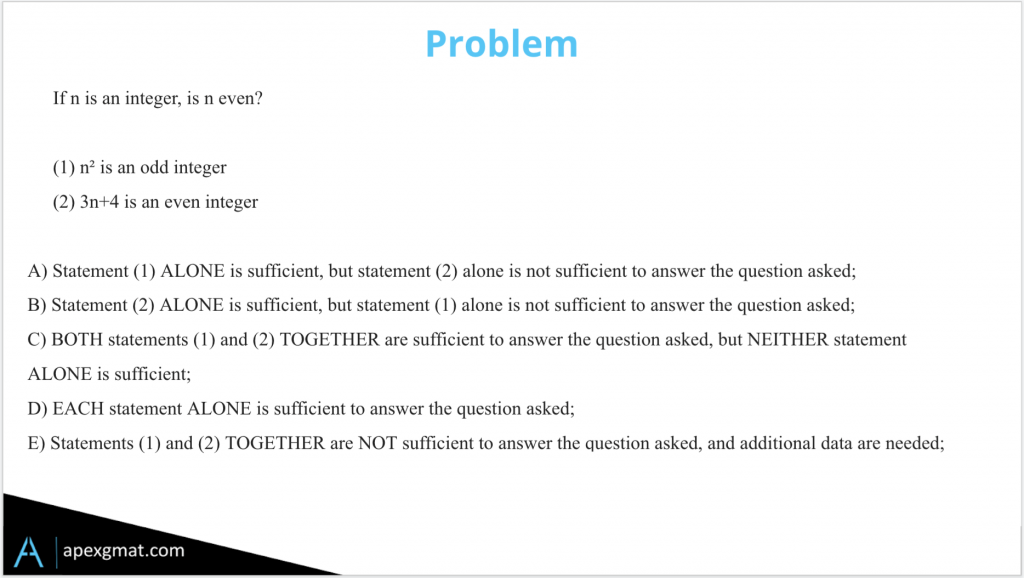Abstract Data Sufficiency Problems & Scenarios
Hi guys! Abstract data sufficiency problems tend to really lend themselves to running scenarios – It doesn’t matter if it’s an abstract inequality or a number theory problem, really anytime you’ve got variables thrown into the question stimulus on a DS problem, scenarios is a good way to go. Now your scenarios can be discrete actual numbers that you throw in there, but you can also leverage rules and have more conceptual-level scenarios. We’re going to take a look at both in this problem.
Problem Introduction

We’re being asked here for the evenness or oddness of n which is an integer. At first blush, we’re going to say, “Well, if we have the evenness or oddness of any expression involving n and n alone, we should be able to backtrack it to n.” If you don’t see that then you might fall into the trap of having to go much more deeply into it and figure out “Well, what if n is this, what if n is that?” But notice here that because we’re dealing with evens and odds there are a set of identities that govern every possible addition, or multiplication, subtraction, or division of evens and odds. So, as long as there’s nothing complicating it the expression itself will be enough.
Statement 1
Taking a look at the introduced information, number one gives us n2 + 1 is odd that means that n2 is even. How do we know without numbers? If n2 + 1 is odd then adjusting it down by one, removing that one, means we’re definitely going to get to an even, because the number line is just even, odd, even, odd, even, odd all the way up. So, we have n2 is even, and only even times even gives us an even. Odd times odd doesn’t, odd times odd gives us an odd.
So, n must be even if the square of it leads us to an even. Notice again, that we don’t need to do any of that, it’s enough just to say we’ve got n in an expression, and we have its evenness and oddness.
Statement 2
Number two works the same way. 3n + 4 is even that’s enough, no more to do, but if we want to we can adjust that 3n – 4 as even down by 4 notches (odd, even, odd, even). So 3n is even and then we know that n divided by 3, that is what is an even divided by 3, will give us n. An even divided by an odd is going to always be an even, for the same reason even times an odd is always going to be an even.
Run some scenarios here, start out with an even number; let’s do 6, 50, and 120. Divide each by 3; 2 (6/3=2), 50 divided by 3 doesn’t work, 40 (120/3=40). So on the two that do work, we get to even numbers. 50 is not allowed to be used as a scenario because we’re told that n – 3 has to be an integer which means, that 3n must also be an integer; that is 3n is a multiple of 3. Since 50 is not a multiple of 3 it’s not a potential 3n. Take a minute with that one, because it’s kind of looking at everything in reverse.
So here we have two different expressions that both give us evenness and oddness, they both work independently. The answer choice is D – each alone is sufficient.
If you enjoyed this problem, try your hand at these Data Sufficiency Problems GMAT Trade Show Problem & Area of a Triangle Problem.
